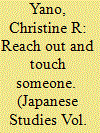|
|
|
Sort Order |
|
|
|
Items / Page
|
|
|
|
|
|
|
| Srl | Item |
| 1 |
ID:
143818


|
|
|
|
|
| Summary/Abstract |
This article examines historical and contemporary Japanese attitudes toward the `ukulele (and Hawai`i) configured as paradisical objects of yearning and utopian desire. This is desire in the form of what I call a ‘plucked paradise’ – a form of music-making upon a stringed instrument, as well as the image of a flower being harvested for one’s use. Plucking a string produces a relatively delicate sound that decays quickly; plucking a flower is a small act of aesthetic appropriation. Both of these reference a paradise that is temporal, sensual, and aestheticized. This research asks, what kinds of meanings do participants give to the `ukulele and its music in Japan? How do infrastructural components, particularly Japanese Americans, facilitate the development of `ukulele culture in Japan? By analyzing multiple dimensions involved in the creation of that ‘plucked paradise’, I bring to bear the tensions, conflicts, and creative forces that shape the interaction.
|
|
|
|
|
|
|
|
|
|
|
|
|
|
|
|
| 2 |
ID:
104165


|
|
|
|
|
| Publication |
2011.
|
| Summary/Abstract |
Hello Kitty (b. 1974) in the year 2009 was all grown up. Indeed, Sanrio, the mouthless feline's maker, took the opportunity for a year-long celebration of her 35th anniversary that extended into 2010. Thirty-five: the year marks the standard end of young adult promise in Japan, after which traditionally new employment opportunities close, scholarships for post-baccalaureate education end, and fertility rates in women decline. But what does 35 years mean for a product? More specifically, what does it mean for a product that has achieved iconic status as a symbol of youthful innocence dubbed kawaii (cute) in ever-widening, global settings? Among other things, 35 years suggests the possibility of true trans-generational appeal, especially with mother-daughter pairs of Hello Kitty fans. In the case of Hello Kitty, 35 years also signals a sufficient time span from which nostalgia may be considered viable and ultimately marketable. In this paper I use Hello Kitty's 35th anniversary as a lens upon kawaii - Japanese Cute - by which we might look backward and forward to the consumer culture surrounding this now 'middle-aged' object, primarily in Japan, but extended through its global applications.
|
|
|
|
|
|
|
|
|
|
|
|
|
|
|
|
|
|
|
|
|